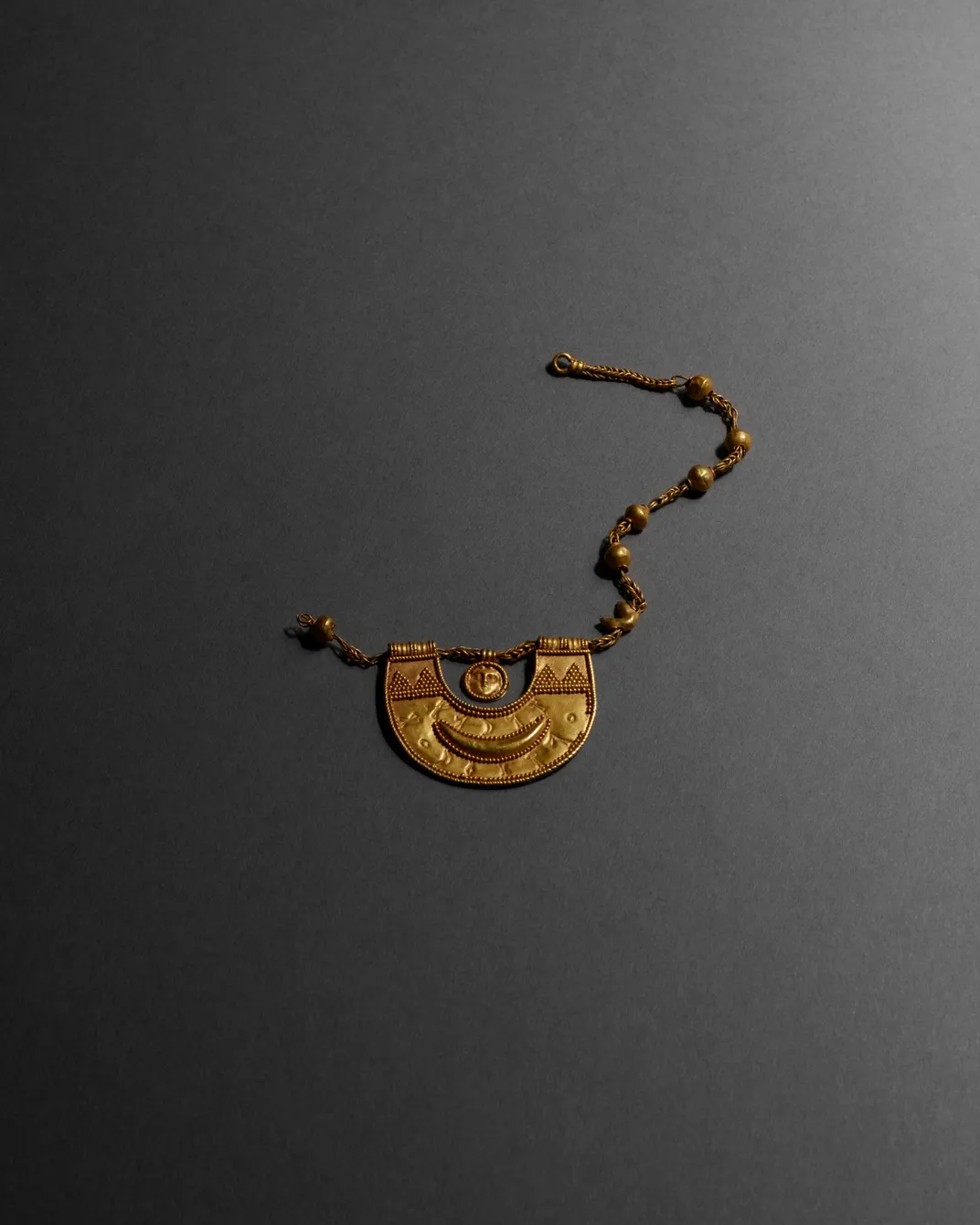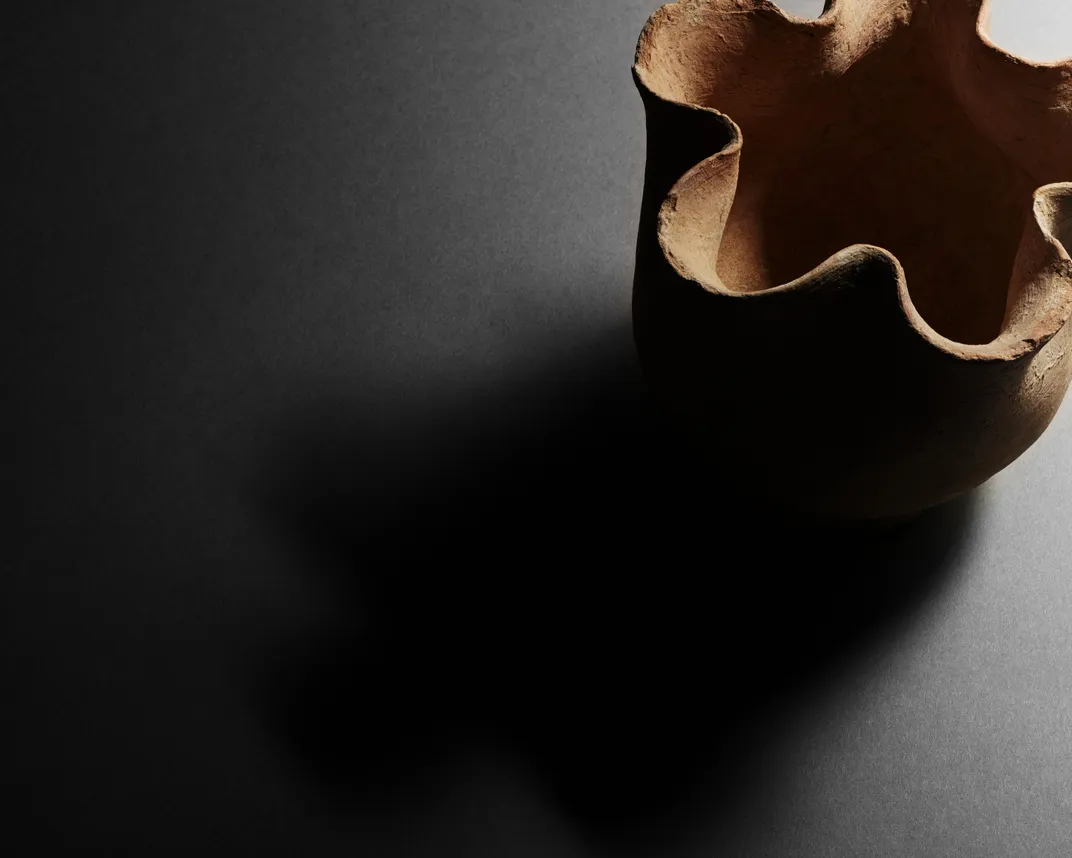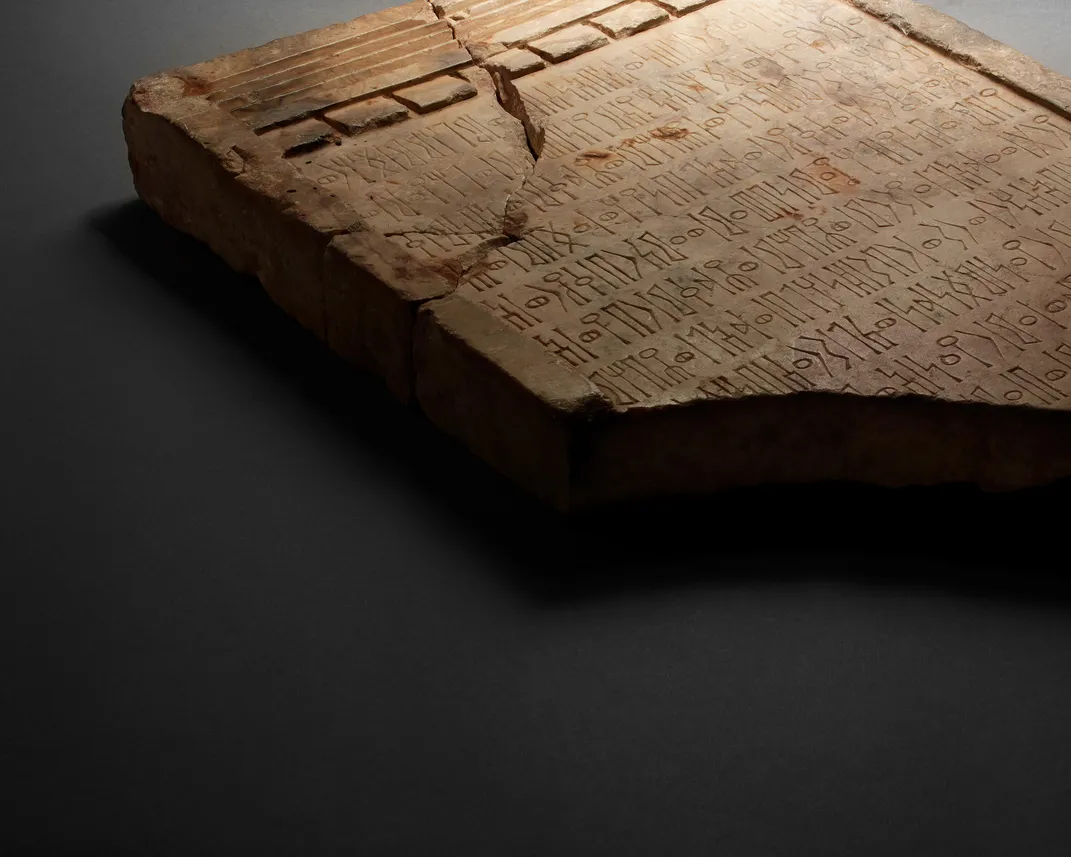The old reels of 16-millimeter film give off the sour, tangy smell of vinegar. These rusty film cans and little curlicues of movie clippings were hauled out of South Arabia more than 60 years ago, and some of them haven’t been watched since. Now they fill a storage room of the Smithsonian Arthur M. Sackler Gallery with the distinctive odor of decaying acetate. The first reel has just been digitized, and it’s playing on a nearby computer screen now.
The moonscape of the Yemeni desert scrolls by. There are close-ups of toiling camels, and huge, quarrelsome spiders, and regal dancing girls, their hair dipped in camel urine to keep it smooth. Archaeologists with sunburned necks whisk away at hunks of limestone.
And then a skinny, rather pale figure appears on-screen in aviator shades and a red-and-white headdress, a pair of pearl-handled Colt pistols by his side. He looks rough and dashing—and also a bit like a boy playing dress up.
“That’s Wendell! He’s drawing his .45! Fantastic!” shouts Rocky Korr, a retired collections manager who remains the museum’s reigning expert on the mid-century explorer Wendell Phillips. Korr, like me, is witnessing these scenes for the first time. “No one has seen this. No one has seen this. Oh, fabulous— now he’s shooting!”
A hapless can of peaches hops around in the sand as Phillips sprays bullets, but it’s a little unclear what he is aiming for. He styled himself a steely-eyed gunslinger, bragging that his personally engraved six-shooters were his “most valuable insurance policy.” Yet he seems to have used them mostly to intimidate the giant spiders, and to entertain the Bedouin locals. And of course, Colt was one of his expedition’s sponsors.
It’s difficult to overstate how famous Phillips was in the 1940s and ’50s, when—at the tender age of 26, with no credentials, training or connections—he organized a series of daring and extravagant archaeological quests in Africa and the Middle East, culminating in Yemen, where he led the first-ever American dig to a nearly disastrous end. Upon his return to America, Phillips was named one of the Top Ten Young Men of 1954, alongside Chuck Yeager and Robert Kennedy, and Lowell Thomas heralded him as “America’s Lawrence of Arabia.”
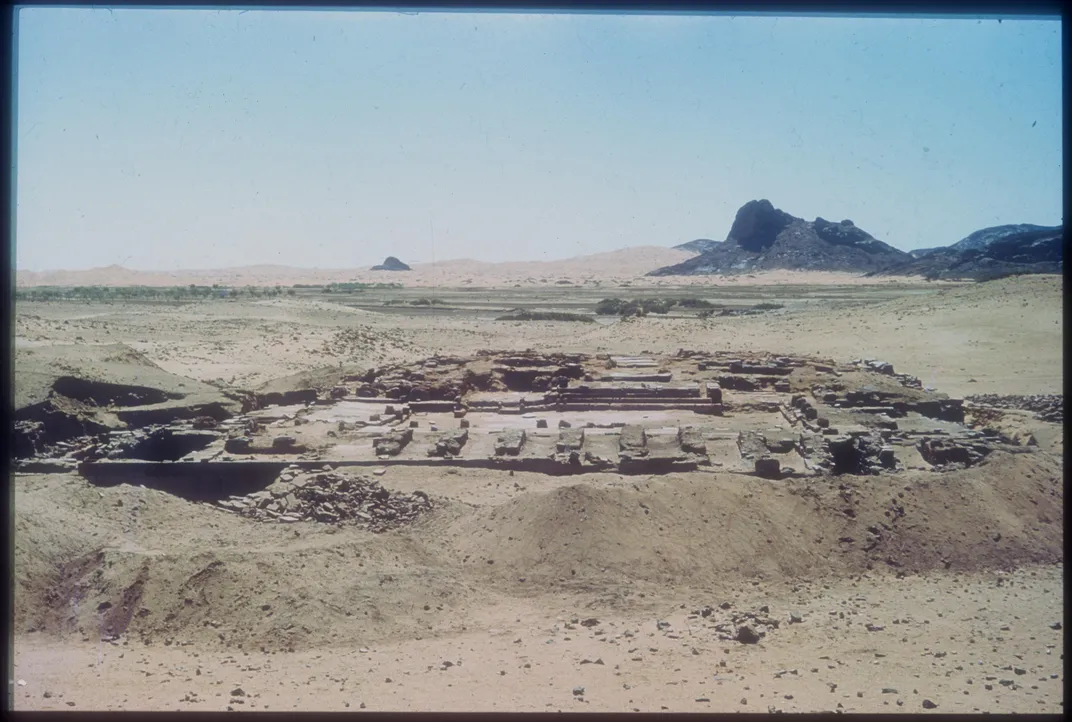
Rumors have even circulated that Phillips could have provided an inspiration for the character of Indiana Jones. He once described being served a dish of eyeballs in a sultan’s palace while getting fanned by palm fronds. He staffed his expeditions with beautiful women, including a truck driver with “the figure of a mannequin” and a 19-year-old secretary so attractive that he feared she would be annexed into a local harem. He talked of discovering buried treasure and pledged to find traces of the Queen of Sheba. Indeed, he brought his own movie cameras into the desert, took countless publicity pictures, held international press conferences and telegrammed President Truman, all in between visits to his mom.
Hollywood flourishes aside, Phillips also delivered the goods, gathering over several field seasons what’s still considered to be one of the finest and most coherent collections of ancient Yemeni artifacts outside of South Arabia, housed partially in the Smithsonian. The collection’s scholarly significance has only increased in recent years, as excavation work in Yemen is at a standstill due to the country’s civil war and intensifying humanitarian crisis.
All of which makes it fascinating that this extremely memorable, manically accomplished man, who was born almost penniless but was rumored to be one of the wealthiest Americans when he died in 1975, has by now been all but forgotten. Today his archaeological colleagues are mostly gone, and Phillips left no children—his closest living relative is his younger sister, who still controls much of his collection.
“It seems so strange that someone who was so prominent disappeared,” says Julian Raby, the Sackler Gallery’s former director. “But people go in and out of fashion.” The explorer himself has become an exotic figure ripe for rediscovery, and his motives and significance are subjects of considerable debate. Did he do more harm than good? Was he a prodigy or a tomb raider?
In the South Arabian desert, “facts get buried deep,” Phillips wrote. “But a few clues survived the neglect and erosion of time.”
The degraded Phillips film we’re watching is flocked with flickering white figures that aren’t really there. Archivists refer to these flaws as “ghosts.”
* * *
Because the ancient Yemeni revered a lunar god, Phillips called them “the children of the moon.” He himself was born to a woman named Sunshine, and hated to be called a “child,” which happened quite often as his young career took shape. (“Kid Phillips,” detractors nicknamed him, and “Billy the Kid.”) He grew up in Oakland, in an old-school California family. (His mother had prospected for gold in the High Sierras, perhaps seeding her son’s taste for the stuff.) As a 10-year-old during the Depression, Phillips earned money hawking newspapers, and later led Treasure Island tours during San Francisco’s World’s Fair to fund his undergraduate studies in paleontology at the University of California at Berkeley. Then, like so many of his peers, he left college to serve in World War II, joining the merchant marine.
Despite the many adult dangers of the Pacific theater, it was a children’s disease that crippled him: infantile paralysis, or polio. Bedridden afterward in a Maryland hospital, unable to walk, the 24-year-old Phillips wrote to William F. Albright, a world-famous archaeologist who happened to work at a university just down the road. Soon Albright was visiting the stricken young man nearly every day, apparently bowled over by the charisma of this “slender, enthusiastic person” who was “thin to the point of being a shadow” even when in the pink of health. They discussed the finer points of field archaeology until eventually Phillips was discharged back to college.
Albright was quite startled a few years later when the garrulous former invalid reappeared at his doorstep, now very much in motion, and having apparently persuaded the president of the University of California, officers of the U.S. Navy and others to appoint him to lead an unprecedented exploration of Africa. The expedition would traverse the entire continent and cover “research problems in tropical medicine, paleontology, geology, anthropology, archaeology and other fields,” according to Phillips, who knew hardly anything about any of these fields, and who had never even been to Africa. Would Albright like to come along? A virtuoso pitchman, Phillips made his case. “I tried to turn my back on temptation,” Albright later wrote, “but Wendell was too persuasive, and shortly after midnight my last defenses collapsed.”
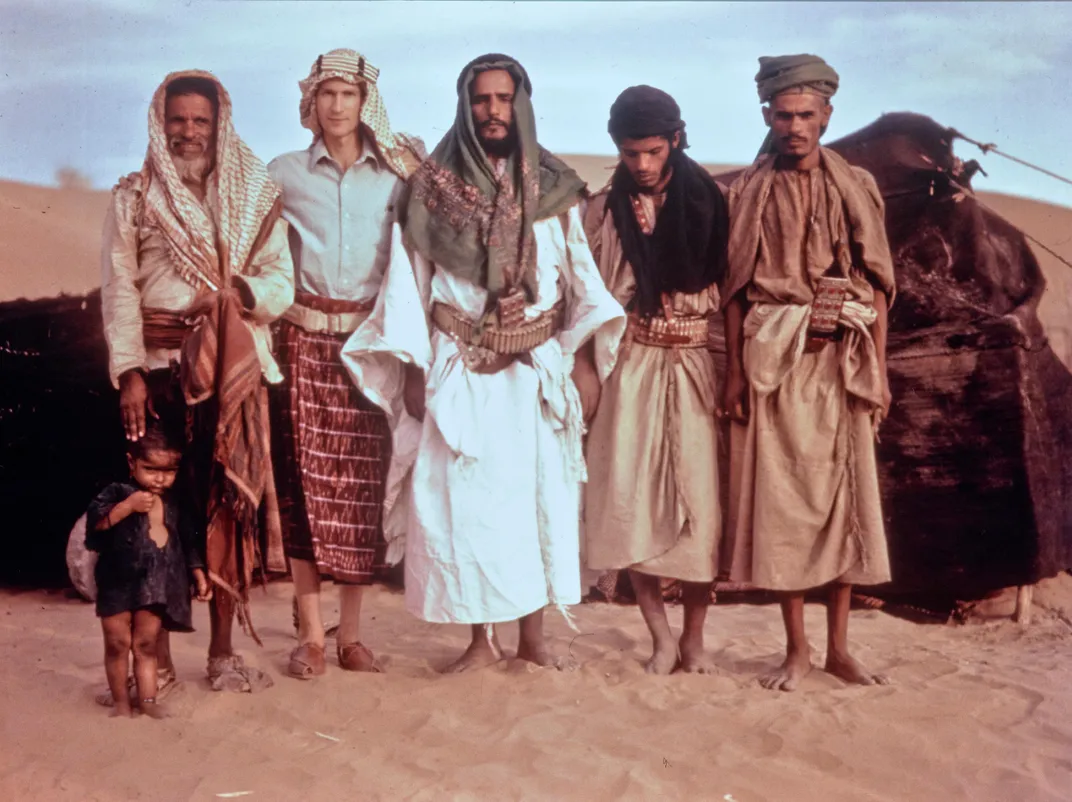
Ultimately the junket involved more than 50 scholars and technicians, dozens of trucks and an airplane and lasted 26 months, the largest American excursion of its kind. The team’s splashy and diverse discoveries made newspaper headlines, ranging from the fossilized remains of a nine-foot-tall “ape man” (an early hominid from Swartkrans, South Africa) to a new route that Moses might have taken across the Red Sea.
Perhaps most fatefully, while in Africa Phillips—who had an uncanny knack for running into people—happened upon the Aga Khan, the wildly wealthy imam of the Nizari Ismailis, who was relaxing at his posh Serengeti hunting camp. The powerful ruler suggested that Phillips direct his energies next at southern Arabia, specifically the area including modern-day Yemen, and Phillips took his advice to heart. “It was one of the least-known very important areas of the world,” he reasoned. No American archaeological expedition had ever worked there.
Phillips devoted himself to fund-raising: “It was in New York, before the shining desks of businessmen, and moneyed audiences, that I’d raised most of the cash.” He systematically charmed the executives of Pan American, Heinz and Chrysler, among others, also accepting donated supplies, from Dodge Power Wagons to Fairbanks Morse generators, whose brand names he would obligingly drop throughout his adventures.
In 1950, Phillips led an uncharacteristically streamlined team of 15 people to the southern part of modern Yemen. Then called the Aden Protectorate, this zone was British-controlled and considered much safer than other parts of the region, though the disputed border country was just a few miles away.
Upon arrival the explorers were already short on cash, and confusion arose when their ample supply of Log Cabin Syrup (General Foods was a Phillips backer) was mistaken for illegal rum. At last, silver-tongued Phillips secured the appropriate permissions and the team barreled off through the dunes toward the ancient city of Timna.
“We were without question the world’s best-equipped expedition,” Phillips boasted in a dispatch to Collier’s magazine. “We were push-buttoned, refrigerated, both motorized and also armed like Marines.” They had adding machines and Colt pistols aplenty.
Unfortunately, Phillips had forgotten to pack the shovels and baskets needed to displace thousands of years of desert sand, and these essentials had to be scavenged or otherwise scrounged from local people.
But then, at Timna, they began to find things.
* * *
Korr, the resident Phillips specialist, leads me back into the museum’s glass-cased collections, where an array of treasures from the blazing Arabian desert is laid out on a long, cool conference table.
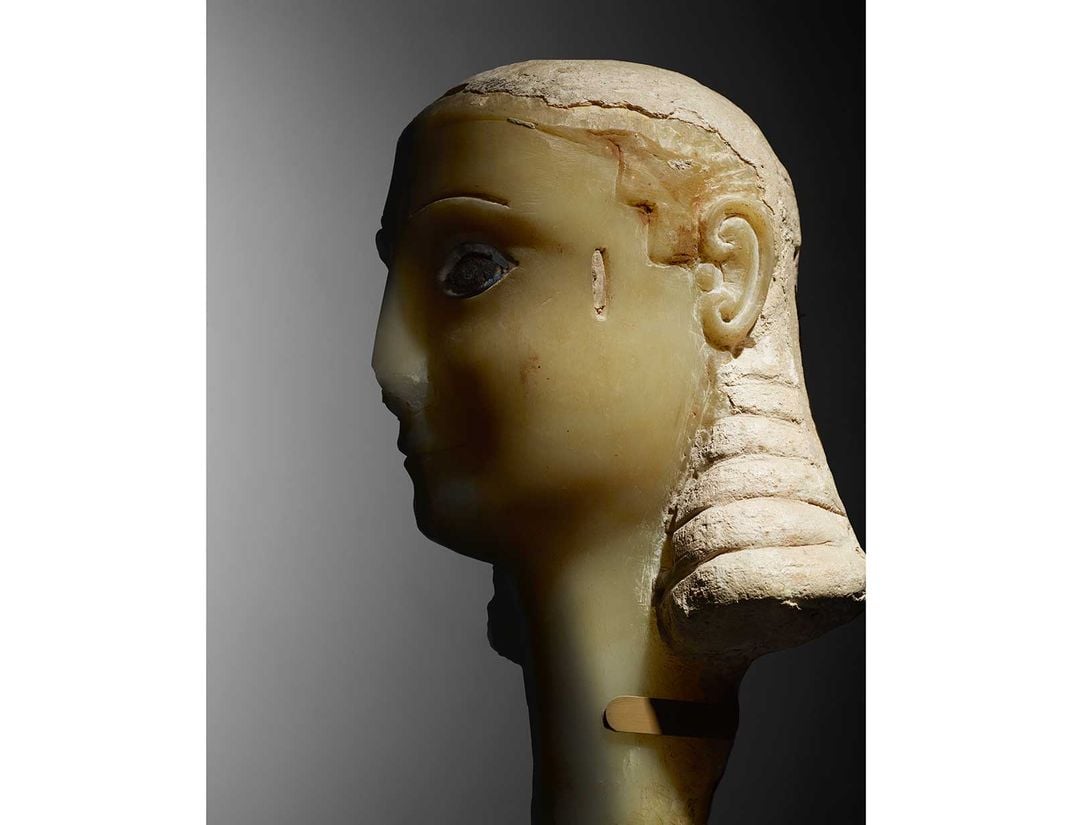
I meet “Miriam,” an alabaster beauty from the first century B.C. whose creamy complexion, dimpled chin, and eyes flecked with lapis lazuli remind me of Jessica Chastain. Phillips’ stunned workmen christened the head as soon as it emerged from the sands of the cemetary associated with ancient Timna. And here is an intricate necklace, the only major piece of gold the Phillips expedition ever found, emblazoned with a crescent moon. The piece was unearthed at the same site as Miriam, and scholars have long wondered whether the necklace was meant to adorn her slender stone neck.
Even more spectacular are a pair of large green lions pawing the ground, their ears and nostrils flared, their oxidized coats dark with age. These so-called “Lions of Timna” have been displayed alongside the world’s finest Hellenistic bronzes. Small bronze boys sit astride their backs.
The most exciting Phillips pieces may be the humbler objects that reveal details of daily life in ancient South Arabia. Korr grins down at an unassuming earthen pot. “Isn’t it cute?” he says. With its wavy rim, it’s a rare example of a distinctive Yemeni style. An alabaster beehive-shaped jar, used for food storage, is another quintessential local piece.
Best of all is a banded agate bead found near Timna. Squinting at it one day, Korr was amazed to see the profile of a tiny carved miniature camel head emerge. “I couldn’t believe it,” Korr says. No scholar had ever noticed this perfect flourish.
Today war-torn Yemen is one of the world’s more isolated regions, but “Happy Arabia,” as the ancients dubbed the realm, was once the cosmopolitan and bustling hub of the global frankincense trade. Harvested from certain South Arabian trees, this redolent resin was transported, via camel caravan and ship, across the ancient world, and perhaps as far away as India, as priests of myriad faiths ignited the frankincense at their shrines, starting circa 1,000 B.C. or even earlier and peaking around the end of the millennium.
The South Arabians, who quite literally had frankincense to burn, traded with and taxed the passing camel caravans, enriching themselves with imported products from far-off lands. Korr handles some of the foreign goods found at Timna: a Greek lead-glazed cup, with one handle still intact, and a brass chalice all the way from Egypt, emblazoned with lotus leaves. (Two thousand years later, the Phillips expedition also trafficked in exotic drinking vessels, mostly of the Coca-Cola variety.)
The frankincense wealth let ancient Arabian rulers engineer and irrigate the arid landscape, allowing for robust agriculture that would have otherwise been impossible in a desert. Forty miles from Timna, at the ancient city of Marib, sat a mammoth earthen dam that once watered the region. Marib was also the capital of fabled Saba, or Sheba, whose storied queen was the ultimate ambassador of caravan culture. According to the Old Testament, the queen traveled to Jerusalem, by treasure-laden camel caravan, to quiz wise King Solomon—perhaps around 950 B.C. She was apparently satisfied with his answers. “Never again were so many spices brought in as those the Queen of Sheba gave to King Solomon,” reported the wowed author of the Book of Kings.
Some scholars think the glamorous desert monarch to be imaginary; others that she really hailed from Ethiopia. She exists in precisely the zone between myth and history that one would expect to attract an Indiana Jones.
Around the fourth century A.D., the overland frankincense market foundered, perhaps because the discovery of various trade winds enabled speedier delivery via ships, or maybe because Catholic officials began to frown on frankincense because of its pagan associations. As the camel caravans dwindled, South Arabia’s wealth dried up and with it, the irrigation systems. Marib’s magnificent dam and others ultimately failed, and sand slowly swamped the historic kingdom of Sheba and everything else.
* * *
The busts and pots that Phillips and his team unearthed in his two novice field seasons in South Arabia were fascinating finds: They illuminated particulars of a vital regional trade system and helped map out the whole civilization’s chronology.
What Phillips didn’t discover at Timna, though, was a headline-grabbing trophy. “If he was looking for King Tutankhamen’s tomb, he didn’t find it,” Korr says. “This isn’t El Dorado. Miriam is great, but she’s not from the Parthenon.”
Would Phillips’ Manhattan patrons have been satisfied with a bunch of crumbly jars and severed alabaster heads? “What we don’t know,” Korr says, “is what promises were made. Were the sponsors wondering, ‘Where is all the gold and jewelry?’”
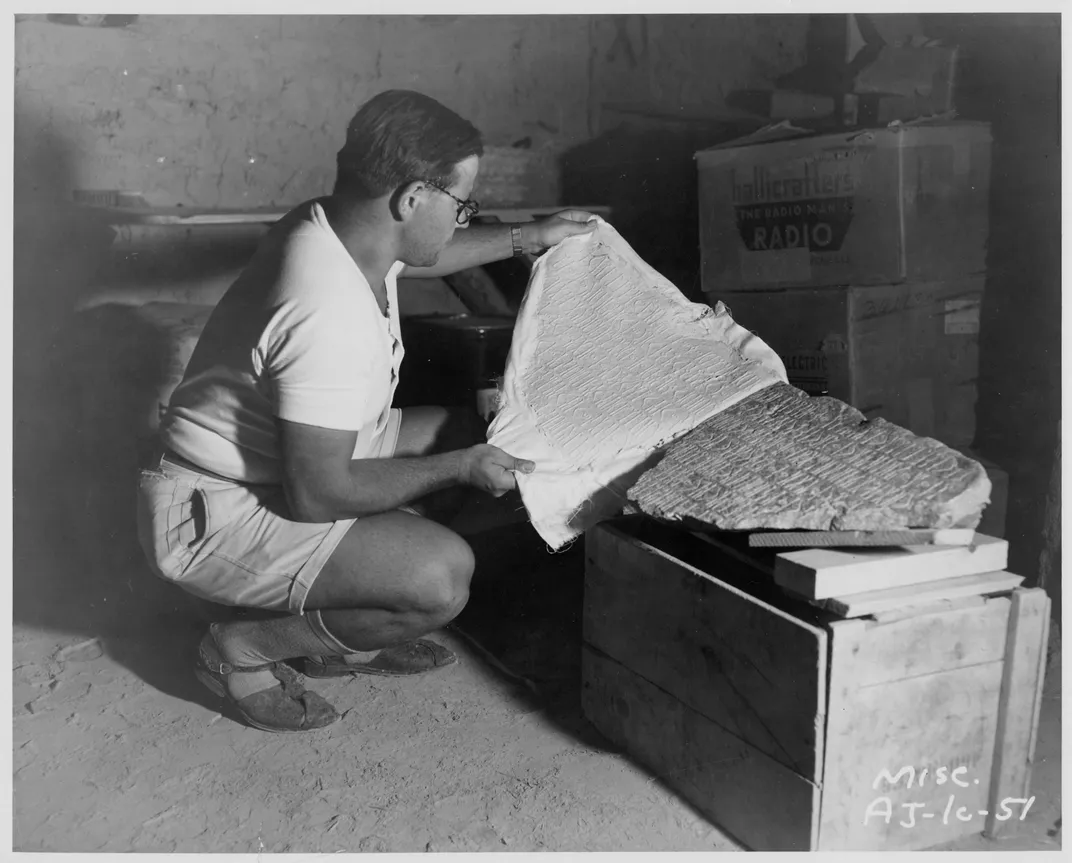
Officially Phillips insisted that he and his team sought a lost culture, not flashy treasure. He was in awe of Albright and the other academics on his expedition, who pored over faded inscriptions for hours in the frying-hot sun. Their scholarly ideals, he sometimes implied, were lost on the uneducated locals. “We were interested in gold objects because of their artistic and archaeological value,” he said of negotiations with the regional Bedouin ruler Sherif Hussein, whom he otherwise admired. “The Sherif was interested in their monetary value.”
Yet there are hints that gold was ever so slightly more enticing to the young explorer than unglazed potsherds.
For one thing, Phillips couldn’t get the Queen of Sheba and her gold-burdened dromedaries out of his mind. When dancing girls performed by moonlight, he imagined that she had resembled them. “We continued to wonder about the Queen,” he wrote, “always hoping to uncover something that would bring her out of the mists.” The hard, thirsty work at Timna “could take many years of excavation” without ever yielding a slam-dunk discovery. Though it lay in dangerous country beyond British control, legendary Sheba beckoned. It was a mere 40 miles away. Perhaps Phillips would be the man to find some definitive trace of its fabled queen.
“There is no reason to doubt, as many do, that she actually existed,” Phillips wrote. “It should be confirmed by archaeology soon and we hope to be the first.”
So Phillips began making plans to leave the relative comforts of the Aden Protectorate and the patronage of the Sherif, who had let the Americans help themselves to what was, even then, considered a rather scandalous share of the recovered Timna artifacts. (Today, it would be illegal to remove any finds from the country, and even in the 1950s countries like Egypt had far more sophisticated and self-interested approaches to partage, as the division of finds was called.)
In fact, for all his purported greed for gold, the genial Sherif gave Miriam’s precious necklace to Phillips, although it was the Sherif’s according to the terms of their agreement. (Phillips could charm Bedouins just as well as businessmen, and had already bestowed upon the Sherif a GE deep freeze, among other mid-century American treasures.) As the archaeologists prepared to depart, the Sherif even made Phillips an honorary sheikh, fitting his slender American friend with a tribal headdress. “I was so touched I could hardly speak,” Phillips later wrote.
Phillips, however, was also gleeful: He’d snagged an unprecedented meeting with the reclusive king of Yemen to discuss excavating at Marib. “I tried to act like the dignified leader of a scientific expedition,” he wrote, “but inside I felt like a little boy who has just discovered a whole mountain of ice cream—and his favorite flavor at that!”
The king, of course, was soon swayed—for the moment, at least. Phillips and his team were free to cross the border from British territory into forbidden Marib to dig, with the Queen of Sheba in their sights.
* * *
The main temple at Marib is dedicated to the moon god Ilumquh. Phillips had already noticed the crescent moon—now Islamic, but previously an ancient pagan symbol—everywhere in South Arabia, painted on women’s foreheads and stamped on incense burners. “I could easily see how a godless people, seeking something visible to worship, would choose the moon,” he mused. “Its light was kindlier than the brilliant sun’s, and its effect on...alabaster cities and green fields turned dark velvet by night must have been inspirational.” It was by moonlight that dancing girls jingled and tom-toms boomed, and farmers fearful of fiery tribal conflicts plowed their fields in coolness and comparative safety after dusk.
The lunar temple’s massive main enclosure was rounded, like the moon, and may have at one point circled a sacred water source for camel caravans. At night the whole limestone structure likely glowed. Inside it was decorated with alabaster bulls’ heads and related motifs, since Ilumquh often took the shape of a bull, with crescent-shaped horns. There were stone troughs for collecting bulls’ blood, and a larger-than-life bronze bull statue once stood within. One of its hoof prints remains today, as though the moon god had just briefly stepped away.
Some half a dozen massive square pillars marked the temple entrance when Phillips first rolled up from his plunge across the desert (as usual, he’d taken the shortest route over the surest). “This temple was just too much for us,” he wrote, getting out of his truck to marvel. For half an hour, the young man who once feared that he’d never walk again strolled where no American had ever stood.
Unfortunately, in his excitement to explore the sacred site that he fervently hoped was somehow linked to the caravan queen, Phillips had neglected to pay his respects to the local dignitaries of the present day. Upon arrival in the nearby town, he and his team members were promptly taken prisoner. The explorers were soon freed, but the historic venture was not off to a good start.
Day by day, under the desert sun, tensions between the Americans and the Yemenis simmered. In addition to archaeological near-disasters—one of the huge square pillars almost toppled on some Yemeni workmen—the conflict stemmed from a deeper culture clash. Many of the locals were still in the habit of painting their faces blue with indigo and wearing sharp, curved daggers, or janbiyas. They had never seen technologies like a tube of lipstick, or a typewriter or a wristwatch. Yet here were these white-skinned strangers bearing suspicious camera gear, conveyor belts and gas-guzzling automobiles who wanted to build a road and an airplane runway to cart away crates of old stones.
Muslim diggers complained that the archaeologists did not allow adequate time for prayer. And into this remote, religious land, where women were seldom seen outside their husbands’ harems, Phillips imported a comely secretary with a penchant for off-the-shoulder sundresses. (The lipstick was hers.) He had also brought a Catholic priest, an expert in ancient languages.
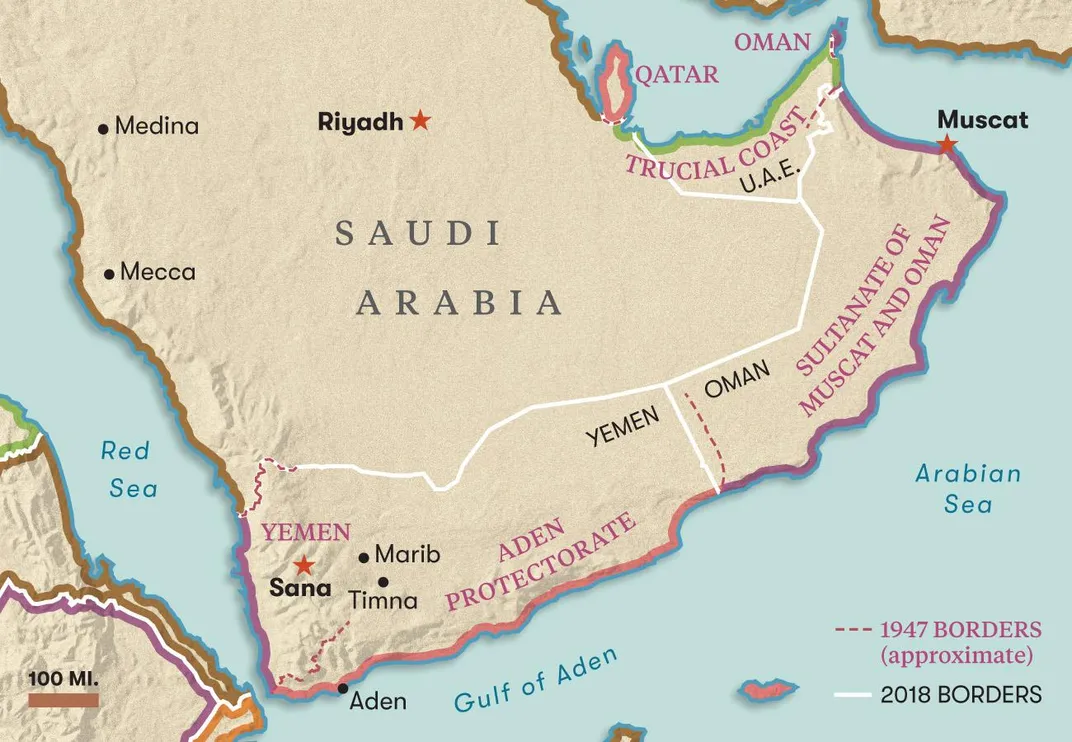
Mostly, though, Phillips seems to have been taken aback that local officials felt a kind of ownership over the artifacts the excavators found at the moon temple, the majority of which Yemeni soldiers seized upon discovery and kept locked in a guarded storeroom. These bothersome bureaucrats even exhibited keen interest in the “worthless” objects, like the latex stone-rubbing copies, or “squeezes,” that the polyglot priest made of temple inscriptions. In fact, the Yemenis wanted their own copies of these copies, and formal instruction in the lost dialect in which the inscriptions were written. To the Westerners, accustomed to more colonial arrangements, these were time-consuming distractions.
Grievances multiplied. The Yemenis allegedly smashed windows of one of the explorers’ trucks, shot their pet dog and spit at the priest. Phillips’ people-magic seemed not to work in this place. The local officials were “ridiculous, impossible.” Reasoning with them was like “lecturing to a herd of camel.”
The moon temple yielded stunning finds, including a striding intact bronze warrior, as well as thousands of inscriptions that testified to an astoundingly literate ancient society. Yet still there was no gold, and the Queen of Sheba had eluded them entirely. Phillips was feeling increasingly frustrated and even frightened. Supplies at Marib grew short and Phillips felt that his group was being deliberately isolated. Fuel for a return journey was running out.
“None of us really believed, of course, that the surrender of the latex squeezes would end our difficulties,“ he wrote. It seemed to him increasingly likely that the locals would hack the priest to pieces with their janbiyas and seize the secretary for their own purposes.
“Somehow, we decided, a way must be found to reach the outside world.”
Phillips decided to make a run for it. All of the team’s high-tech equipment and priceless artifacts would be forfeited, save a few smuggled banners of latex and some photographs concealed in a box of Post Toasties.
Moonlight almost foiled their escape. “Because of the full moon,” Phillips reported, “it had been impossible to hide the rifles, ammunition and water on the trucks.” But in the morning they were all ready, cool as cucumbers, except perhaps for the secretary, who had dressed for the desert in a favorite fur coat that she refused to leave behind.
The explorers accompanied the pesky officials to the moon temple one last time, pretending to want to film a movie of them there. But upon arrival, Phillips’ driver floored the gas.
“The soldiers started to shout something,” Phillips recounted, “but I could not hear what they said. Their words were forever lost in the wonderful roar of our Power Wagons.”
You can almost hear the Indiana Jones theme song swelling. The “camel cavalry,” as Phillips dubbed the mounted Yemeni forces, would never catch them now.
* * *
The most valuable thing that Phillips salvaged from Marib was this story, and he told it, to his backers, to newspapers (which lapped up the tale of the “bloodthirsty Bedouins”) and ultimately in a winsome and popular memoir.
The Yemenis, however, offered a very different account, claiming that Phillips’ hair-raising escape was entirely staged. “The suggestion that there had been any effort to kill members of the Phillips party, the imam indignantly denied,” said Hermann Frederick Eilts, then the American consul in Aden, in a later interview. Rather, Phillips had owed local diggers thousands of dollars in back wages and had fled rather than pay up. (Eilts believed the Yemeni version of events.) This dispute became “the better part of U.S.-Yemeni relations for a year and a half,” and finally some of Phillips’ donors fronted the money so the equipment could be retrieved.
In the meantime, Phillips struck up a friendship with the sultan of Oman, where his much-diminished team soon excavated next. Sensing that Phillips’ true genius was for salesmanship, not scholarship, the king put him in charge of selling oil, awarding him rights to a desert area “the size of Indiana.”
Over the years, the young explorer parlayed his holdings in Oman (which never yielded much oil) to more mineral rights in Venezuela, Indonesia, South Korea and elsewhere. Now middle-aged, Phillips had become a “moneyed” man behind a “shining desk” like those he himself had once petitioned. At one point Phillips was the Americas’ largest oil concessionaire, with an empire valued at a then-whopping $120 million.
Now the once-insatiable self-promoter mostly disappeared from public view, with newspapers offering only a few eccentric glimpses. The mysterious millionaire lived in a Waikiki penthouse on the side of a volcano, his apartment “furnished entirely in Arabian motif.” He owned only two suits, but traveled with some 200 pounds of luggage, most of it research material for a biography of Jesus. At the age of 46, Phillips married an 18-year-old Hawaiian; reporters gleefully described the thigh-high slits in her wedding gown and their minute-long nuptial kiss. (The newlyweds divorced three months later, citing “grievous mental suffering.”)
Twinkles of Phillips’ old curiosity and zeal remained—he and a son of Charles Lindbergh briefly teamed up to “seek the hulks of Portuguese caravels, Turkish galleons” and other wonders in the Gulf of Oman, though little apparently came of the venture. And all the while Phillips continued to refer to oil concessions as his “hobby” and exploring as his calling.
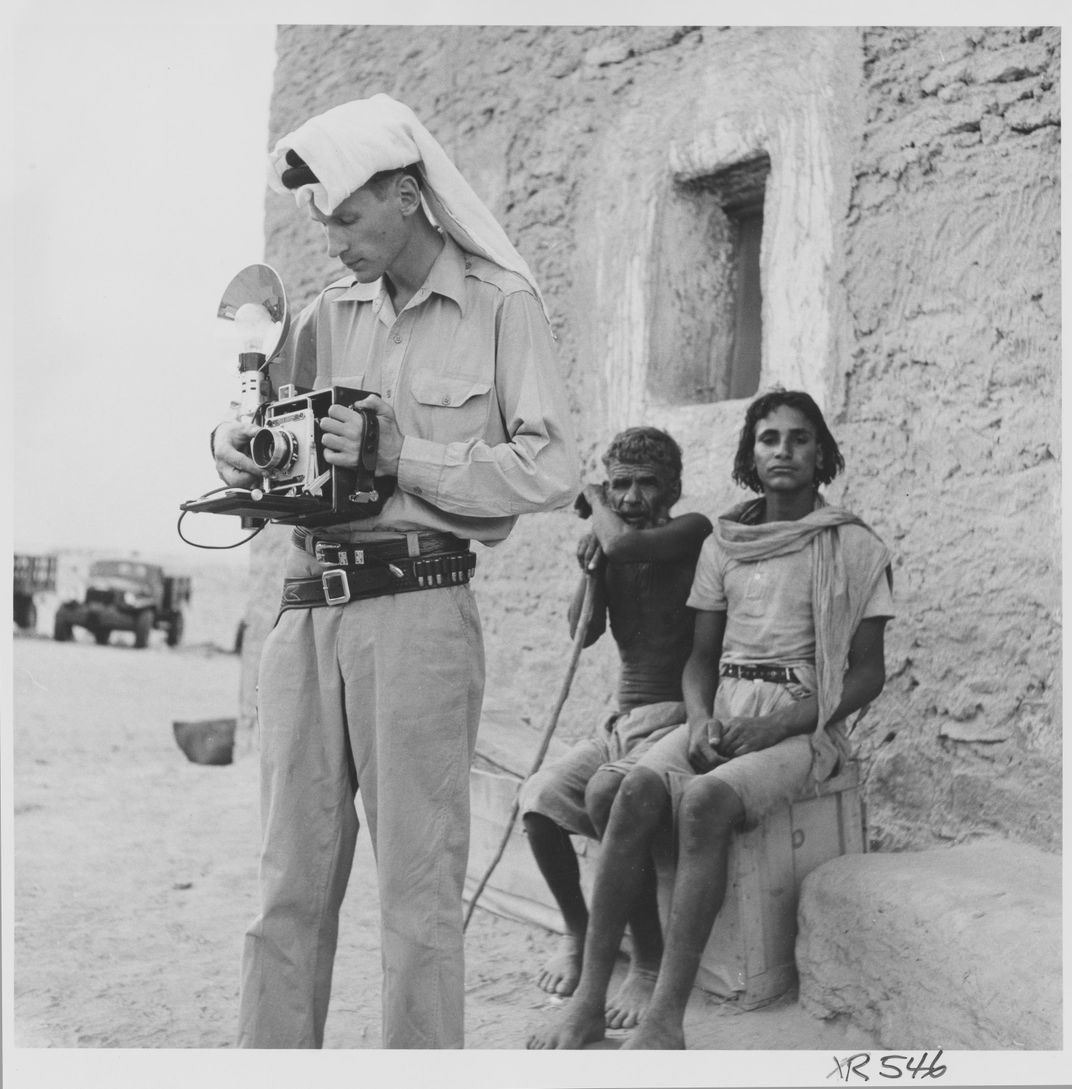
“I’m tired and worn out and want to go back to Arabia,” he once told the New York Times. “I want to go back to the field again, where a man can live.”
After an unexplained illness, the boy explorer died at the age of 54.
* * *
The tiny woman who answers the door of this suburban home is Phillips’ elderly sister. Merilyn Phillips Hodgson claps me heartily on the back and I feel a jolt of the family charisma. She is wearing a jaunty leopard-print scarf, tropical pink lipstick and tall furry boots, which contain two lead feet, I realize when we get on the highway and she goads me to ever-greater speeds. “Can’t you pass him?” she shouts. “We don’t have much time!”
We are headed to the rural farm where the rest of Phillips’ Timna artifacts are stored. And, like Phillips, I’m also hoping for a glimpse of a glamorous past. While not quite the Queen of Sheba, Phillips grows more distant and obscure with each passing year. Facts get buried deep here.
Phillips’ archaeological legacy has not aged well. The discipline, which now prizes the study of minute details of ancient life, from bone fragments to pollen grains, has all but abandoned Phillips’ monumental approach. For some scholars today, Phillips is a ridiculous figure, if not a dangerous one, whose work could be said to smack of imperialism and capitalist excess.
“The word is loot,” says the Near Eastern archaeologist Carl Lamberg-Karlovsky, professor emeritus at Harvard University. “His excavations were not excavations. They were mining operations. He was not an archaeologist. Look at the pictures of him. There he is in the desert, looking like a swashbuckling privateer, two pearl-handled pistols at his side. He built a legend around himself.”
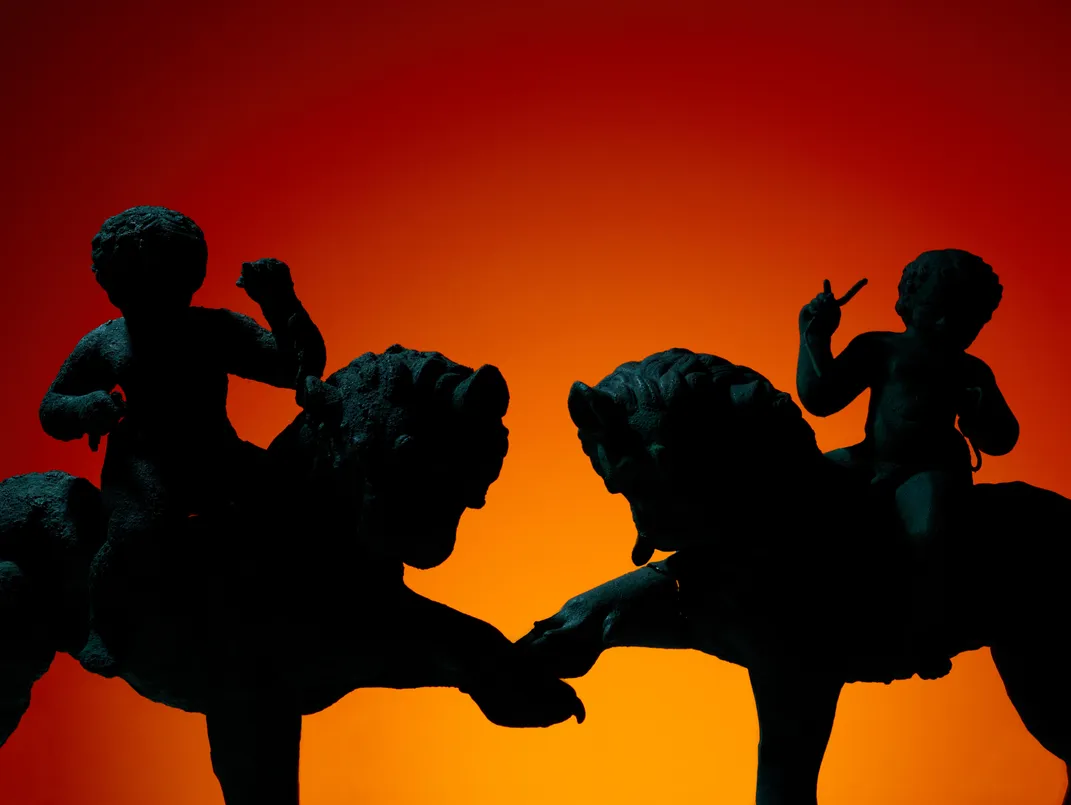
But Phillips deserves far more credit, says Julian Raby. The early 20th century had plenty of “entrepreneurial archaeologists,” and at the time “these were heroic figures.” They are “excoriated” now because our standards have shifted and the archaeological rules have been revised. Phillips helped to open an entire ancient culture to formal study, and his colorful persona still entices us to learn more about little-known Yemen: “He’s someone who can kind of make the desert bloom for people,” Raby says, “and there are some who prefer academic aridity.”
Indeed, Phillips, via his personal foundation (which his sister runs today), has posthumously funded several American expeditions to Marib and the surrounding areas, when the political climate of Yemen has permitted them. These latter-day digs have been staffed with sophisticated modern scholars, including Lamberg-Karlovsky, who excavate in a thoroughly modern and culturally sensitive fashion. But in 2007, suicide bombers rammed a busload of Spanish tourists visiting the moon temple, and no American team has returned since. The structure is once again disappearing under sand.
At the farm, I tail Hodgson and her overseer in their pickup truck, following an off-road route over rolling green pastures. Our caravan is briefly stalled when I leap from my vehicle, then return to slay a huge spider (though perhaps not of South Arabian proportions) with my rental car agreement. Regaining my composure, I look up to find myself under the frank stare of a Black Angus bull. Like her brother, Hodgson has become a cattle rancher. I remember Ilumquh.
Hodgson shows me some rather extraordinary red velvet couches from Waikiki, and Phillips’ janbiya collection, and a group of dusty limestone sacrificial troughs. “The blood came out here,” Hodgson points. Somewhere a pearl-handled Colt pistol is hidden, but she won’t show me where.
Our last stop is an isolated warehouse. What looks like a ten-foot-long brown banana peel hanging from one wall is actually a python skin. There’s a skunk-fur rug—no, Hodgson corrects me, a monkey-fur rug. When I finally have a moment to look up, I see that the moon temple’s iconic rectangular columns have been reconstructed in an atrium-like structure at the center of the warehouse, centered around a bubbling fountain of water.
The whole place is lined floor to ceiling with ancient stone and clay artifacts from Yemen and Oman. Hodgson has given many of the intact pieces to the Smithsonian in recent years. What remains are mostly fragments: human faces cleaved in half, bulls with their snouts sheared off, and thousands upon thousands of potsherds.
For a minute it all seems a little vast and hopeless—the decades separating me from Phillips, the tens of centuries stretching between us and the people who made this jumble of beautiful objects.
In another room, a single pot stands in a basin of sand. It’s badly broken but repaired in several spots, and light comes through the seams. Hodgson sometimes invites archaeologists here to explore the objects. Slowly somebody is fitting this one together, piece by piece.
:focal(2845x-217:2846x-216)/https://tf-cmsv2-smithsonianmag-media.s3.amazonaws.com/filer/95/db/95db068e-79d6-4f3e-8898-0c3a2b273b68/mar2019_f11_extended_lg_americanlawerence.jpg)
